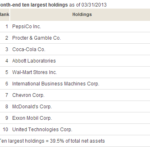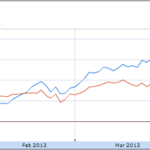Exchange-traded fund investors use ETFs for any number of reasons. Many use them for their simplicity, others know that low ETF fees bring about higher, long-run returns. What many investors seem to forget, however, are the unique risks that come with underlying portfolios that make up any ETF.
Now that commodities are on fire – silver, gold, and even oil have surged since from 2008 financial crisis lows – investors see commodities as a valuable asset class. While ETFs offer exposure to commodities inexpensively and conveniently, exchange-traded commodities funds have a unique risk: contango.
Contango’s Source
To understand contango, an investor must first understand how commodities funds operate. There are a few different ways that an exchange-traded fund can buy exposure to a particular asset class:
- Physical holdings – Most commonly found in precious metals funds, ETF issuers accumulate stockpiles of gold, silver, and now even copper to back a fund’s investment interest. This can be costly for less valuable commodities, since storing many million barrels of oil is far more expensive than storing several million dollars of gold.
- Futures and derivatives – Futures and derivatives can be used to mimic a physical position in a particular commodity. A fund may buy several different long- and short-dated futures positions to simulate the ownership and possession of a particular commodity.
Investors have typically favored physical holdings when the economics make sense. In the case where the economics of owning large scale depositories of a particular investment do not make sense, investors usually turn to funds backed by futures and derivatives.
Both the United States Natural Gas Fund (UNG) and iPath S&P 500 VIX Short-Term Futures ETN (VXX) funds are backed by futures and derivatives. Natural gas is expensive to store in the form of physical holdings – not to mention a massive fire hazard! The volatility index is a derivative of options pricing, so there is no way to buy a VIX to hold it in your hand like a commodity or share of stock. Aligning your investment interest with the VIX requires futures, derivatives, or a combination of both.
Contango Explained
Contango exists when the price of a particular commodity, index, or exposure to any investment vehicle via derivatives is priced higher in the future than in the present. Oil, for example, might be priced at $100 in the current future contract. The next month, known as the front month, might have a price of $102 per barrel, a 2% increase over the month before.
Contango is found in virtually every market for several reasons. First, one must consider the time value of money – if prices are assumed to stay constant, the market still prices in the opportunity cost of capital. Secondly, investors find longer-dated futures to be more valuable because there exists more time for their call to be proven right. If you believe oil will rise to $110, you would want to make sure that you have futures far enough into the future that the markets can have time to “catch up†to your prediction.
Now, when it comes to commodities ETFs and some derivatives-based funds, contango can be a real investment killer.
Using our example above where oil is priced $100 today and $102 in the front-month, we would lose some $2 per barrel every time the contracts are rolled over. That is, if I own 10 barrels of oil at $100 and want to roll over my position, I’ll have to sell my $100 oil to buy $102 oil to extend my position.
Over time, the cost of contango quickly adds up. Investors slowly see the value and size of their position shrink as they own smaller and smaller amounts of a commodity or derivative position with each passing month.
Devastating Effects
The United Natural Gas Fund (UNG) is a perfect example of the devastating effects of contango. From February 2009 to February 2012, the fund lost 85.3% of its value. Meanwhile, the price of natural gas dropped only 50%.
That is to say that the fund would have lost roughly 50% of its value if it had purchased natural gas and stored the gas itself. However, because the fund rolled countless positions over each month (many of which were front-run by traders to push up prices before rollover) the UNG fund dropped 85.3% in the same period.
The short version of this long story is that $10,000 invested in natural gas in 2009 is worth roughly $5000 today. The same $10,000 invested in UNG 3 years ago is worth only $1,470.
Beat Contango
There is only one way to beat the contango for most commodities and derivative-based ETFs – opt for an ETN. Because ETNs are notes, which aren’t backed by real positions on the market, there is no rollover cost each month and thus no contango. However, a new risk does present itself – counterparty risk – the risk that the issuer goes bankrupt and cannot guarantee the value of the note.
When it comes to counterparty risk vs. contango, you’ll simply have to pick your poison!
Written by JT at MoneyMamba.
Disclosure: The author does not have any positions in the above securities mentioned in the article.











{ 1 comment… read it below or add one }
Wow, I knew contango adversely impacted returns, but that UNG example is horrific!